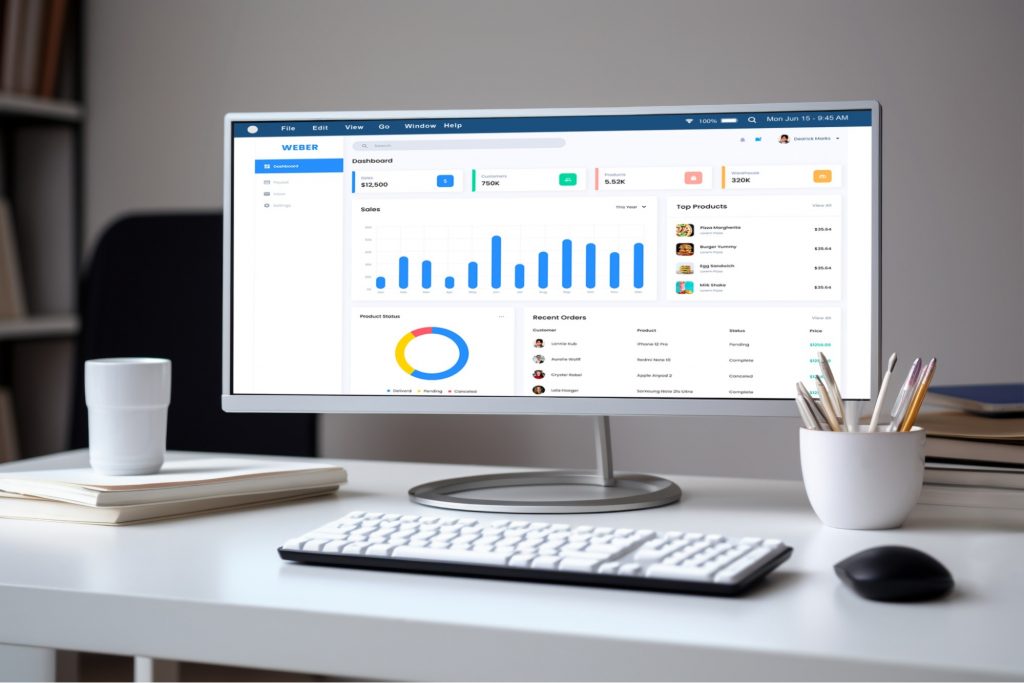
The Ultimate B2B Content Audit Checklist

Source: Freepik
Are you looking to improve your B2B content marketing strategy? A content audit is a great place to start. By analyzing your existing content, you can identify what’s working, what’s not, and what can be improved.
A majority of marketers (61%) carry out content audits at least twice per year, according to the Semrush 2023 Report on The State of Content Marketing.
However, content audits can be overwhelming, especially if you don’t have a clear process in place. That’s why we’ve compiled the ultimate B2B content audit checklist to help you plan, execute, and strategize for your next content audit.
Our checklist provides a clear, specific content audit goal and key steps to remember when executing your content audit. These steps will help you improve your content’s overall quality.
What Is a B2B Content Audit?
A B2B content audit is a systematic review of all your content assets, including blog posts, whitepapers, case studies, and videos, to evaluate their performance, relevance, and impact on your marketing goals.
Benefits of a Content Audit
A content audit offers a myriad of benefits, ranging from enhancing performance to aligning your content with your audience’s needs. The key advantages include:
1. Insights Into Content Performance
A content audit gives you insight into how your content is performing. It shows you what works and what needs to be improved.
By looking at your content, you can figure out what topics, formats, and channels your readers are interested in. With this information, you can create more content that resonates with them.
For instance, you may discover that your audience is more engaged with video content on specific topics or that they are more engaged with longer articles. With this in mind, you’ll be able to create content that’s tailored to your audience and not only engages them but also keeps them on your site longer, improving your overall user engagement metric.
This will lead to an overall improvement in content quality and a boost in website traffic.
2. Improved SEO Performance
A content audit can be the key to improving your content for search engine visibility. By identifying content that is not performing as expected, you can update it with relevant keywords and meta descriptions as well as other SEO techniques to improve its search engine visibility.
Additionally, a content audit can be used as a compass to identify areas of your content strategy that need improvement. Beyond keywords, you might uncover opportunities to improve technical SEO elements, like optimizing images or fixing broken links. This ensures that your content not only ranks higher but also provides a seamless and enjoyable experience for your audience.
This will result in an increase in organic visitors to your website, as well as an increase in your ranking in search engine results.
3. Enhanced User Experience
Make sure the content you have is not just user-friendly but also up to date and matches the tone of your business.
You may identify holes in your content strategy and choose content that really speaks to your target audience by performing a content audit. This greatly improves the overall user experience on your website, keeping users engaged and accomplished.
A content audit is similar to giving your website an upgrade to make it more user-friendly and appealing for visitors to remain on the site and explore. Apart from adjusting to the tone of your brand, you may also learn which interactive components (such as surveys, infographics, and quizzes) work best for your audience and improve the user experience on your website as a whole.
4. Increased Engagement
The content audit makes it easier to find articles that engage your audience and understand why they work. You can produce more of the content types that your audience responds to most effectively by analyzing your existing content. But the content audit’s insights go beyond simply pointing out trending subjects. You can go further into understanding the particular components of effective content that draw in readers. For example, you may find that content with interactive elements, storytelling, or images draws in more viewers.
Prepared with these fine-grained insights, you can produce more captivating content and customize it to your audience’s particular tastes, leading to a deeper and more lasting engagement on your website and social media channels.
5. Informed Decision-Making
Use the findings from the audit to guide data-driven decisions in your content strategy. By thoroughly analyzing your content, you can make informed choices about what is effective and what is not.
The content audit gives you the ability to strategically determine what should be added, updated, or removed from your content, going beyond just improving individual pieces. This approach optimizes your entire content strategy. The audit can also reveal gaps in your content that can be filled with new and relevant material, ensuring a consistent supply of valuable content for your audience.
Additionally, it helps identify outdated or underperforming content that can be updated or removed, streamlining your content library and improving its overall effectiveness. These deliberate decisions not only enhance the overall effectiveness of your content but also save you valuable time and money, allowing you to allocate resources where they are most needed.
Step-by-Step Process to Conduct B2B Content Audit
In B2B marketing, a content audit serves as a compass that guides you toward your marketing goals. It helps you understand what’s working, what’s not, and how to steer your marketing ship in the right direction.
Step 1: Define Your Goals
The foundation of a successful content audit is setting clear goals. Ask yourself what you intend to achieve through this audit.
The primary goals of a content audit are as follows:
1. Identify Top Performers
Assess how your existing content is contributing to your marketing objectives. Discover which content pieces excel, driving traffic, engagement, and conversions. These are your valuable assets that should be celebrated and replicated.
2. Unearth Poor Performers
Locate content that isn’t bringing in the right audience or convincing people to take action as well as it could. It’s important to spot these underperforming pieces so you can make them better.
3. Understand Relevancy
Determine whether your content aligns with your target audience’s needs and preferences.
4. Generate Better Content Ideas
A content audit unveils the topics and formats that resonate with your audience. It’s an idea generator, giving you insights into what your target audience is seeking.
5. Improve Organic Search Performance
By implementing best SEO practices, a content audit can boost your content’s visibility in search engines and increase organic traffic.
6. Discover Lead Generation Opportunity
Identify opportunities for generating more leads through content.
Step 2: Collect Data
When conducting a content audit, having a structured template is crucial for maintaining consistency. Here’s a breakdown of what your content audit template should include:
1. Content Data
- Page Title: This is the title of the page or content asset.
- URL: The web address where the content is located.
- Content Type: Is it a blog post, whitepaper, case study, or something else?
- Published Date: The date when the content was first published.
- Last Updated: When was the content last revised or refreshed?
- Product Page: Is the content directly related to a product or service?
- Features: What aspect of content makes the user stay on the page for an extended time? What unique elements keep the audience engaged?

2. Technical Data
- Meta Title: The title that appears in search engine results.
- Meta Description: A summary that provides context for the content.
- H1 Tag: The primary heading of the content, typically the title.
- Focus Keyword: The primary keyword you want the content to rank for in search engines.

3. Targeted Audience
- Persona: The ideal customer profile data or user you target with this content.
- Buyer’s Journey Stage: Where does this content fit the customer’s journey: Top of Funnel (ToF), Middle of Funnel (MoF), or Bottom of Funnel (BoF)?
- CTA: What is the call to action? What action do you want the audience to take?

4. Performance
- Number of Internal Links: How many links to other pages on your website are present in the content?
- Number of Backlinks: The number of external websites linking to this content.
- Organic Pageviews: How many people have viewed this content through organic search?
- Time on Page: The average time users spend on the content.
- Social Shares: How many times has the content been shared on social media?
- Comments: The number of comments or interactions on the content.
- Bounce Rate: The percentage of users who leave the page without taking any action.
- CTA Conversion Rate: The rate at which users complete the desired action.

5. Action
- Action Needed: Are changes required for this content? (Yes/No)
- Priority: How urgent is the action needed? Revenue potential (High/Medium/Low) and development efforts (High/Medium/Low)
- Action-Taken Date: Date on which the action was implemented.
- Remarks: Any additional notes or observations about the content.

Step 3: Evaluate Your Content
The heart of the content audit lies in data analysis. This is where you differentiate between content that’s flourishing and content that’s floundering. You’ll want to categorize your content into:
- Outdated Content: Content that is no longer relevant or accurate.
- Converting Content: Identify which content is driving conversions and why.
- Ready to Update: Content that’s good but needs a refresh to make it relevant with the current year.
- Best-Performing Content: The crown jewels of your content strategy.
- Underperforming Content: Content that’s not delivering as expected.
- SEO Compliance: Check if your content follows SEO best practices.
- User-Friendliness: Is your content easy to navigate and read?
Step 4: Create an Action
Based on your analysis, you’ll develop a set of action items for each content piece:
- Keep: High-performing, relevant content to retain.
- Update: Content that needs refreshing or minor revisions.
- Delete: Irrelevant or underperforming content to remove.
- Rewrite: Content needing significant improvements.
Make informed decisions based on the audit results, enhance existing content to align with your goals and audience preferences, and tailor your content to match what your target audience is looking for.
Tools for Conducting a Content Audit
To effectively conduct a content audit, you’ll need the right tools. Some of the popular tools include Screaming Frog, Ahrefs, Semrush, Google Search Console, and Google Analytics. Here’s how each tool can help:
1.Screaming Frog:
This tool is ideal for in-depth website analysis. It can help you identify broken links, duplicate content, and other issues that may be affecting your website’s performance. Screaming Frog can also help you identify pages that are not being indexed by search engines.
2. Ahrefs:
This tool is ideal for backlink analysis and competitor research. You can use Ahrefs to find pages that saw an increase/decrease in traffic value and ranking. Ahrefs can also help you identify the most popular pages on your website and the keywords that are driving traffic to those pages.
3. Semrush:
This tool offers a comprehensive suite of SEO and content analysis tools. You can use Semrush to identify the keywords that are driving traffic to your website, as well as the keywords that your competitors are targeting. Semrush can also help you identify content gaps on your website and suggest topics for new content.
4. Google Search Console:
This tool provides valuable insights into your website’s search performance. You can use Google Search Console to find pages with an incline/decline in clicks and impressions. You can also use this tool to identify crawl errors and security issues on your website.
5. Google Analytics:
This tool is essential for tracking website traffic and user behavior. Google Analytics gives you insight into the conversion and UX data. You can use this tool to identify the most popular pages on your website, the pages with the highest bounce rate, and the pages with the longest time on-site.
To get the most out of these tools, you need to know which features to use. For example, with Ahrefs, you’ll want to focus on backlink analysis and competitor research. With Google Analytics, you’ll want to focus on tracking website traffic and user behavior. By using these tools effectively, you can conduct a thorough content audit and optimize your website for better performance.
Takeaway: The Power of a Comprehensive B2B Content Audit
A comprehensive B2B content audit can help you identify gaps in your content strategy, optimize your content for better search engine rankings, and improve your website’s user experience.
By following the checklist, you can make data-driven decisions, create content that resonates with your target audience, and, ultimately, drive better results in the competitive world of B2B marketing.
So, why wait? Implement this checklist today and watch your marketing strategy soar to new heights!



